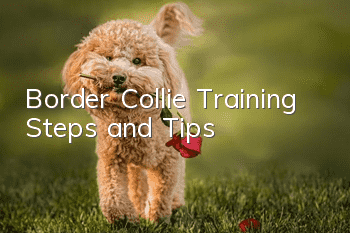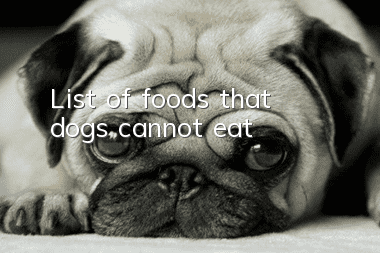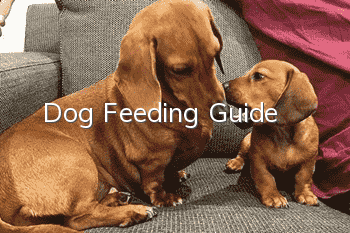Border Collie Training Steps and Tips

When starting training, you can use small pieces of biscuits or beef jerky. First let the dog sit face-up, then take out the biscuits or beef jerky and let it smell it, then step back a few steps, face the dog, and issue the "continue" command. At the same time, throw the biscuit in the direction of the dog's mouth. If the biscuit is thrown just above its nose, most dogs can catch it with their mouth, and the owner will let the dog eat the biscuit as a reward and reinforcement.
If the dog cannot catch it, the owner should quickly step forward to pick up the biscuit that fell on the ground and throw it to it again. Only when the dog catches the biscuit in the air can it be allowed to eat it for reinforcement. After a few times of practice, the dog will understand that The owner's motivation is to ask the dog to catch the biscuits in the air. Soon, the dog will be able to master this game skill.
When the dog reaches the above abilities, the owner can use a ball instead of biscuits for training. At this time, the dog's motivation is not the biscuits, but the game. The owner can let the dog sit or stand, take out the ball and say "Go on" to the dog. "" command and throw the ball upward. Since the dog has mastered the skills of the game, it can often catch it easily. Then, the owner calls the dog to come to him and spits out the ball, giving the dog a reward. With such regular training, the dog's game The desire is getting higher and higher, and the catching skills are becoming more and more proficient, and they often jump up to catch objects in the air. If the dog has this reaction, the owner should fully reward and encourage the dog to master the timing of jumping and the skills of catching objects. Until the dog masters it proficiently.
Then, you can develop the dog's ability to jump to catch objects while running. You can use a flying saucer for training, and the speed of starting the flying saucer should be slow. The owner stands in front of the dog on the right side, vertically launches the flying saucer, and issues a "catching" signal to the dog. After hearing the command, most dogs will fly towards the flying saucer and jump to catch it. If the dog succeeds, the owner should fully reward it to stimulate the dog's interest. If the dog cannot catch it, the training should be repeated until the dog succeeds. As the dog's progress To improve the dog's ability, the owner should change the direction and speed to develop the dog's ability to catch objects.
Training steps: The steps in the initial training of Frisbee dogs are very important. Correct training steps can not only increase the training efficiency, but also prevent the dog from developing bad habits during the training process
Excitement: Excitement is the dog’s desire. When the desire is strong, the learning ability is strong, and vice versa
Disc grab: The owner holds the Frisbee, and the dog takes the initiative to bite the Frisbee
Obedience: Complete actions according to instructions
Tour: Pick up the Frisbee and give it to the owner
Leverage: The dog steps on the owner's body and jumps to take over, mainly including jumping legs, jumping back, and jumping chest
Catch: The owner throws the Frisbee to the dog, and the dog catches the Frisbee in the air
Training steps
Interest mobilization → excitement control → plate grabbing training → obedience training → circuit trainingPractice→strength training→takeover training→reaction speed training→synchronic movement training
Interest mobilization: Use the dog's original interest to make the dog interested in Frisbee, and gradually strengthen it
Excitement control: After the dog becomes interested in the Frisbee, use the Frisbee to adjust the dog's excitement to the best state, and then train the dog
Scratching training: Scratching is the most basic training and the foundation of Frisbee dog training.
Obedience training: After the previous training, using a Frisbee as a reward will be the best way to train obedience
Circuit training: Circuit training is very important. If the circuit training is not done well in the early stage, it will be very troublesome to correct later and the effect will not be good
Leverage training: Leverage training seems to be more difficult, but the training is not difficult. The focus of the training is on grabbing the plate
Reception training: Start training with humans and dogs face to face at close distances, and gradually increase the distance and difficulty
Reaction speed training: The height and method of the dog's jump when catching a Frisbee depend on the dog's reaction speed, so the enjoyment of the dog when catching the Frisbee mainly depends on the training of reaction speed
Fancy movement training: Fancy movement mainly depends on the tacit understanding between the dog and the owner. It is a training that requires time to accumulate
Training methods
Early education - arouse the dog's interest in Frisbee
Method 1: Use the Frisbee as a food bowl for feeding and water
Method 2: Let the dog watch while the owner plays Frisbee
Method 3: Let your dog watch other dogs playing Frisbee
The most important method to master—controlling the dog’s excitement
Method 1: You can see it, you can touch it, you can’t bite it
Method 2: Make the dog feel lost
The most important foundation - bite plate, obedience and circuit training
1. Gradually increase the number of times the dog bites the Frisbee
2. Strengthen the commands "bite" and "spit"
3. Give the dog obedience instructions and reward the dog when it completes
4. Use the rolling plate to train the circuit
5. You can use control ropes to assist training
Based on the bite plate - leveraging training
1. Strengthen the command “bite””
2. Leveraging the legs
3. Chest borrowing force
4. Use back force
Don’t be too hasty - takeover training
1. Remember to act too hastily
2. Flat connection
3. Vertical connection
4. Butterfly connection
The key to jumping - reaction speed training
1. Use multiple Frisbees
2. Gradually increase the throwing frequency
3. Gradually change the throwing height
4. Gradually change the throwing angle
- Which dog is the most loyal to its owner? Let your Doberman Pinscher be loyal and protective of his owner!
- How to take care of a Rottweiler dog after giving birth
- Tips for daily grooming your dog
- What kind of adverse reactions will dogs experience after being vaccinated? Precautions related to dog vaccination!
- Determine the dog’s health status based on the dog’s physical condition
- How to train a Doberman Pinscher? What should you pay attention to when training?
- What's the Bull Terrier's personality like, and is it easy to raise?
- What should English Foxhounds eat after giving birth?
- Why does a pregnant dog have black discharge from its urethra?
- Health Class|Top 10 signs of cancer in dogs



